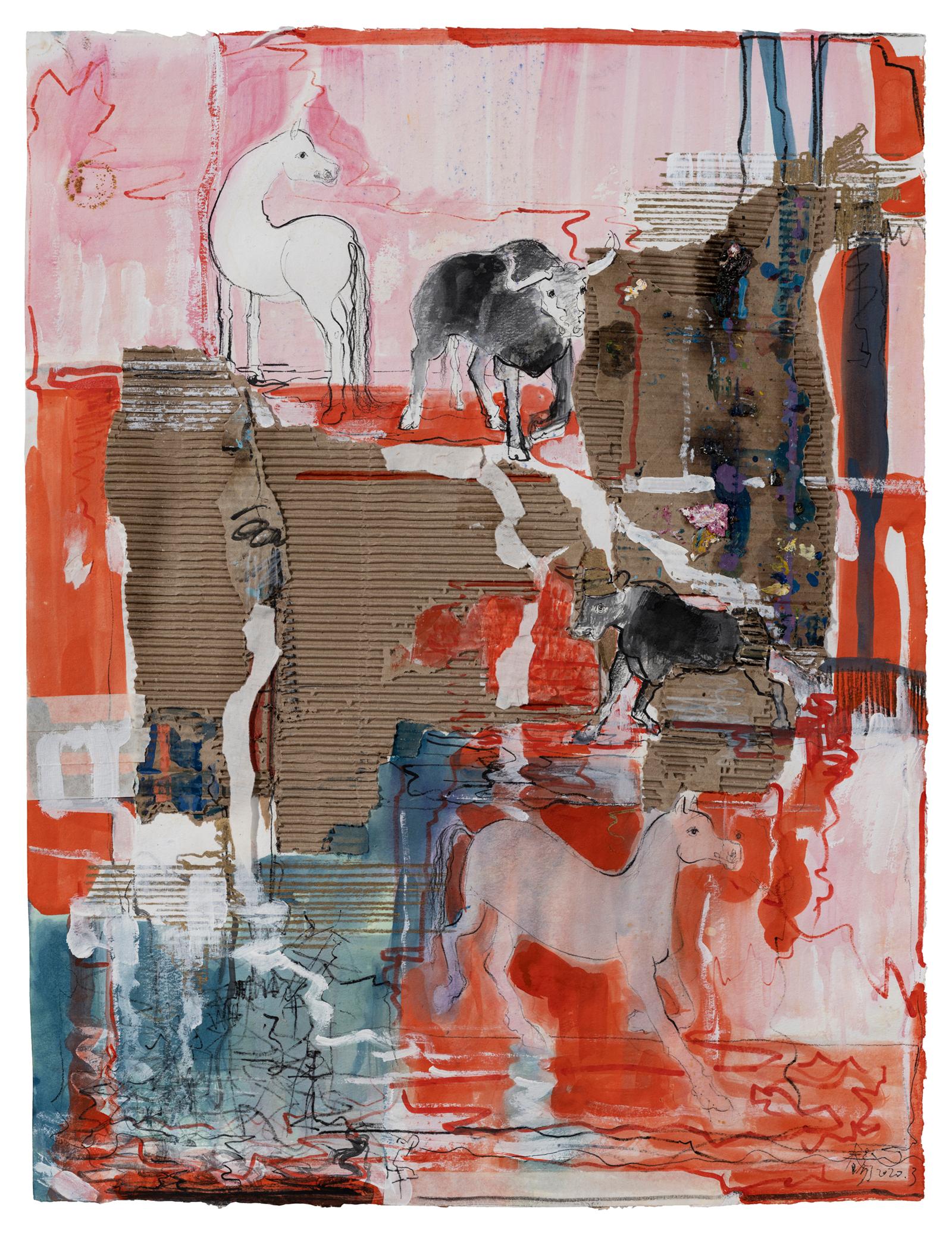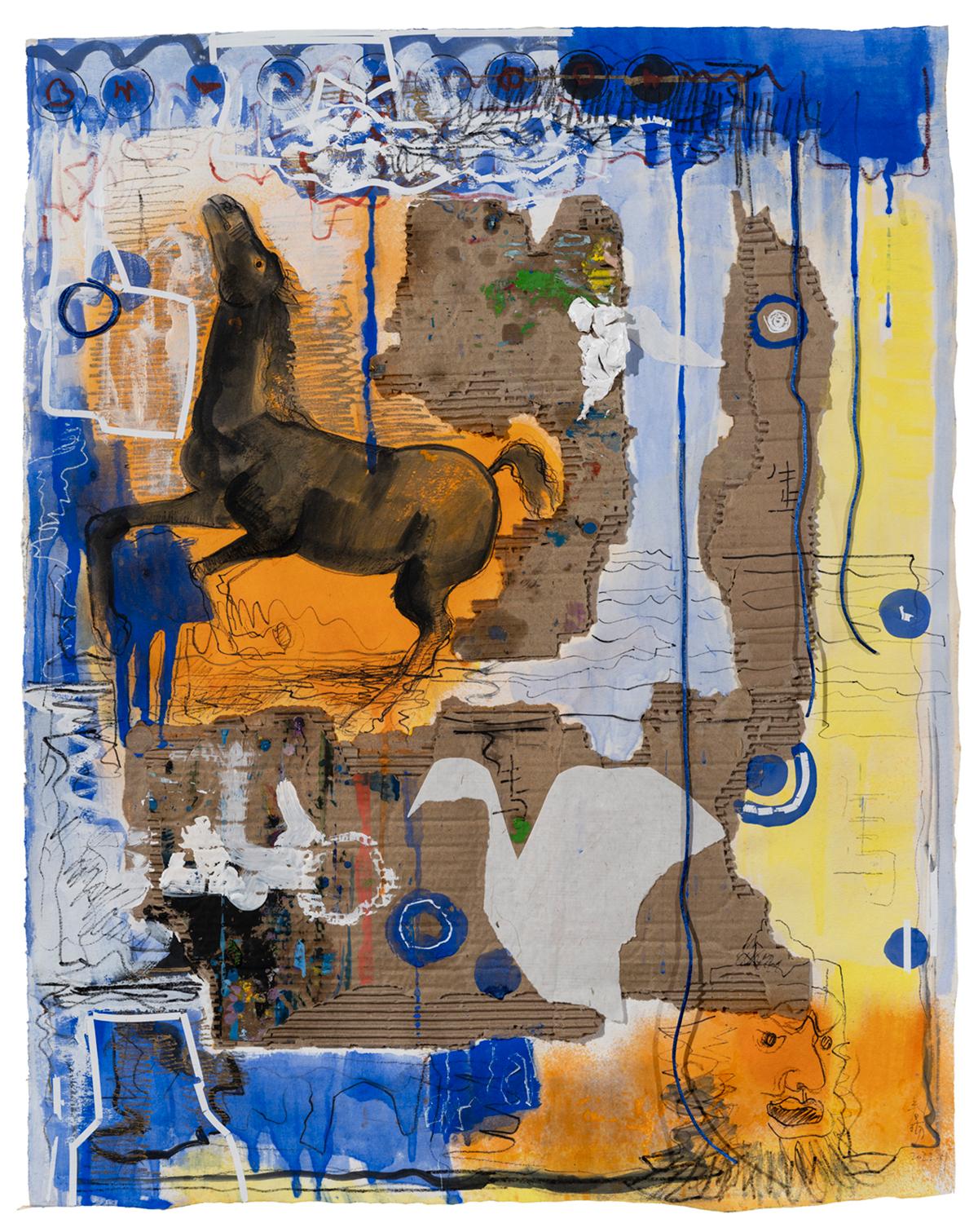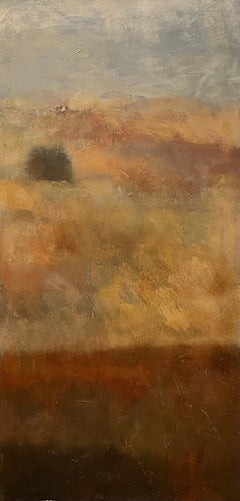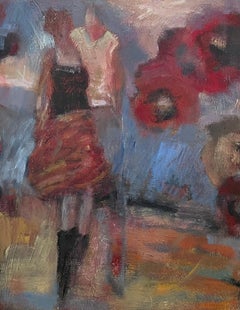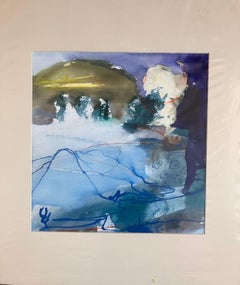Rare Israeli Modernist Figurative Abstract Gouache Painting
View Similar Items
Want more images or videos?
Request additional images or videos from the seller
1 of 9
Yosl BergnerRare Israeli Modernist Figurative Abstract Gouache Painting
About the Item
- Creator:Yosl Bergner (1920 - 2017, Israeli)
- Dimensions:Height: 19.5 in (49.53 cm)Width: 25.25 in (64.14 cm)
- Medium:
- Movement & Style:
- Period:
- Condition:minor wear.
- Gallery Location:Surfside, FL
- Reference Number:1stDibs: LU382715602
About the Seller
4.9
Platinum Seller
These expertly vetted sellers are 1stDibs' most experienced sellers and are rated highest by our customers.
Established in 1995
1stDibs seller since 2014
1,541 sales on 1stDibs
Typical response time: 1 hour
More From This SellerView All
- Rare Israeli Modernist Figurative Abstract Gouache PaintingBy Yosl BergnerLocated in Surfside, FLMixed Media, Watercolor and Gouache Bergner, Yosl (Vladimir Jossif) (b Vienna, 13 Oct 1920). surrealist, surrealism. belongs to the generation of people uprooted from childhood landscapes and forced by circumstance to build a life elsewhere. Uniquely, he became an Israeli without shedding his Jewish cosmopolitan-refugee identity, an identity he zealously guarded in the melting pot of Israel of the "fifties" and "sixties". In the years that have passed since he acquired his art education at the Melbourne National Gallery Art School in Australia, concepts in the art world have changed many times over. from the Jewish paintings and the depictions of Australian Aborigines through the children of safed, the wall paintings, the masks, the angels and kings, the still lifes, the "Surrealistic" paintings, the toys and flowers, the paintings inspired by the Bird-head Haggada, the Kafka paintings, the Pioneers, the Kimberley fantasy (about his father's excursion in 1933 to northern Australia, in search of a "territory for the Jews"), Brighton Beach and the seascapes inspired by Eugene Boudin, through the chairs in the "Kings of Nissim Aloni" episode to the "Zionists" and the recent "Tahies". "During the six years that Bergner has lived in Israel," wrote Eugene KoIb, Direct. or of the Tel Aviv Museum, in the catalog of the Bergner exhibit in 1957, "he has established himself among Israeli artists." Bergner was indeed one of the artists who represented Israel in the Venice Biennial (1956; 1958) and in the Sao Paulo Biennial in 1957; this, in spite of the fact that Yosl Bergner did not harness his art to serve the Zionist ethos, that being, at the time, the order of the day (his paintings were in fact rejected at first as being those of a "Diaspora Jew"); he didn't "naturalize" himself by alliance to the country's landscape or its special light, nor did he turn to abstract painting. Painter of "the Jewish condition". the painter involved in Nissim Aloni's theater and the popular illustrator of poetry books...Category
20th Century Expressionist Abstract Paintings
MaterialsMixed Media
- Boston Modernist Painting Floral Foliage Collage German Expressionist Karl ZerbeBy Karl ZerbeLocated in Surfside, FLKarl Zerbe (1903-1972) A mixed-media Painting collage of mod neon colored leaves on canvas with parchment backing. Hand signed "Zerbe" bottom left and dated bottom right 1965-65. Dimensions: Collage: 36 in tall x 24 in wide. Frame: 40 in tall x 28 in wide. Karl Zerbe (1903 – 1972) was a German-born American realist painter and educator. Karl Zerbe was born on September 16, 1903 in Berlin, Germany. The family lived in Paris, France from 1904–1914, where his father was an executive in an electrical supply concern. In 1914 they moved to Frankfurt, Germany where they lived until 1920. Karl Zerbe studied chemistry in 1920 at the Technische Hochschule in Friedberg, Germany. From 1921 until 1923 he lived in Munich, where he studied painting at the Debschitz School, mainly under Josef Eberz. From 1924 until 1926 Karl Zerbe worked and traveled in Italy on a fellowship from the City of Munich. In 1932 his oil painting titled, ‘’Herbstgarten’’ (autumnal garden), of 1929, was acquired by the National-Gallery, Berlin; in 1937, the painting was destroyed by the Nazis as "Degenerate art." Entartete Kunst was what they deemed all the Avant Garde, Modernism Movements. In the visual arts, sucf innovations as Expressionism, Fauvism, Cubism, Dada, Bauhaus, Post Impressionism were disdained. Artists such as Käthe Kollwitz, Otto Dix, George Grosz, Max Beckmann, Max Ernst, Oskar Kokoschka, El Lissitzky, Franz and Marc Chagall were among those who despite having made significant contributions to the German modernist movement were banned even if they were not necessarily Jewish. From 1937 until 1955, Karl Zerbe was the head of the Department of Painting, School of the Museum of Fine Arts, Boston. In 1939 Karl Zerbe became a U.S. citizen and the same year for the first time he used encaustic. He joined the faculty in the Department of Art and Art History at Florida State University in 1955, where he taught until his death. He was grouped together with the Boston artists Kahlil Gibran (bronze sculpture), Jack Levine and Hyman Bloom as a key member of the Boston Expressionist school of painting, and through his teaching influenced a generation of painters,[including, among others, David Aronson, Bernard Chaet, Reed Kay, Arthur Polonsky, Jack Kramer, Barbara Swan, Andrew Kooistra, and Lois Tarlow. Select solo exhibitions 1922: Gurlitt Gallery, Berlin, Germany 1926: Georg Caspari Gallery, Munich, Germany; Kunsthalle, Bremen, Germany; Osthaus Museum, Hagen, Germany 1934: Germanic Museum (now Busch-Reisinger Museum), Harvard University, Cambridge, Massachusetts 1934, 1935, 1936, 1937: Marie Sterner Galleries, New York City 1936, 1938, 1939, 1940: Grace Horne Galleries, Boston, Massachusetts 1941: Vose Galleries, Boston; Buchholz Gallery, New York City 1943: Mount Holyoke College, South Hadley, Massachusetts 1943, 1946, 1948, 1951, 1952: The Downtown Gallery, New York City 1943, 1947: Berkshire Museum, Pittsfield, Massachusetts 1945, 1946: Art Institute of Chicago, Illinois 1946: Detroit Institute of Arts, Detroit, Michigan 1948, 1949: Philadelphia Art Alliance, Pennsylvania 1948, 1955: Boris Mirski Gallery, Boston, Massachusetts 1950: Munson-Williams-Proctor Arts Institute, Utica, New York 1951-1952: Retrospective Exhibition circulated by the Institute of Contemporary Art, Boston, traveled to: Baltimore Museum of Art; Colorado Springs Fine Arts Center; Currier Gallery of Art, Manchester, New Hampshire; Florida Gulf Coast Art...Category
1960s Expressionist Abstract Paintings
MaterialsMixed Media, Paint
- Chess Game Set French Israeli Surrealist Watercolor Gouache PaintingBy Zvi MilshteinLocated in Surfside, FLThis is a large hand signed mixed media paiting on Arches French paper. A chess game encounter. Figurative Abstract Expressionist painting. Zwy Milshtein (Zvi Tzvi Milstein) BIOGRAPHY 1934 Born in Kishinev (Bessarabia) Russian, Romanian border region. He fled the Nazi Holocaust and in 1948 Arrived in Israel via Cyprus, where he studied with Rafael Ben Zvi. Studies in Tel Aviv with Mordecai Ardon, Aharon Avni, Moshe Mokadi and Marcel Janco founder of the Dada art movement. Studies at The Bezalel Art School, Jerusalem. 1956 Awarded a scholarship by the Israel American Fund. In 1991, Roland Topor invited him to participate in the last exhibitions of the Panique group and collaborated in the review Le Fou Parle. Select Group Exhibitions 1950 55 Israeli Artists Exhibition, Tel Aviv Museum 1956 Cimaise de Paris, 1958 "School of Paris", Charpentier Gallery, 1959 Les Grands et les Jeunes Aujourd hui Salon National 1960 Les Grands et les Jeunes d Aujourd hui Contemporary Israeli Art, Museum of Modern Art, Paris 1961 Russian Artists of the Paris School , Ecole du Paris 1961 Salon de la Jeune Peinture, 1964 Salon des Indépendants, Grand Palais, Paris 1965 Salon d'Automne, Grand Palais, Paris 1966 Lauréat for the Gravure du Prix de la Critique 1967 Biennale, Paris 1970 stay with Theodor Ahrenberg, the eminent Swedish art collector. MILSHTEIN has an exhibition at ARC, in the museum of modern art in Paris. Drawings suspended in a liquid contained in a bottle thus creating a three dimensional effect. 1978 An retrospective exhibition of his etchings engravings is held at the Bibliotheque Nationale; the publication of a book illustrated with 33 drawings : Le rite du chat, on exhibit at Artcurial in Paris. Milshtein has also written several plays and has worked in etching intaglio carborundum, lithograph techniques. listed in adec artprice. He has exhibited at galleries in Germany, France and Switzerland with Theodore Theo Tobiasse, Mane Katz, Raya Sorkine, Avigdor Arikha and Abram Krol. A fine Judaica artist. Since 2007 Milshtein has had his workshop in the Rhône in Gleizé where he also lives. Personal exhibitions 1952: Tel Aviv (Israel), Studio Avni 1955: Tel Aviv (Israel), Museum 1957: Paris, Galerie Saint Placide 1958: Paris, La Cave de la Galerie Saint-Placide - Paris, Galerie Katia Granoff 1959: Tel Aviv (Israel), Museum Dizengoff House 1960: Paris, Galerie Katia Granoff 1962: Tel Aviv (Israel), Chemerinsky Art Gallery - Jerusalem (Israel), Musée National Bezalel —New York (United States), Bodley Gallery - Bat Yam (Israel), Bat Yam Museum 1963: Geneva (Switzerland), Museum of Art and History, Cabinet des Estampes 1964: Paris, Galerie Katia Granoff 1965: Paris, Librairie-Galerie Alexandre Loewy 1966: Paris, Galerie Saint-Placide - Brussels (Belgium), Galerie Le Creuset...Category
20th Century Expressionist Figurative Paintings
MaterialsMixed Media, Watercolor, Gouache
- Jewish Mexican Avant Garde Fiesta of Guadalupe Expressionist Oil PaintingBy Yonia FainLocated in Surfside, FLGenre: Avant-Garde Subject: Abstract Mexican Landscape Medium: Oil Surface: Canvas Country: Mexico Dimensions: Yonia Fain Oil, 1947 Although this oil painting’s subject is predominantly abstract, there is a faint echo of a figural shape at its center. A figure wearing Tefillin, An organic form appears to be pinned to a hammer shaped object, reminiscent of a crucifix. This tool may be a reference to one of the Soviet Union’s symbols. Moreover, it is likely a direct reference to the persecution Fain faced as a Russian Jew in Bolshevik Russia. The contrast between colors, geometric lines, and organic curves is indicative of Fain’s collaboration with Diego Rivera, as well as the time he spent in Mexico. The primary hues communicate the hardship the artist underwent and his cathartic ability to reproduce those emotions through paint. In addition to being a renowned artist and award-winning poet, Yonia Fain is among the few survivors to triumph over the turmoil of the 20th century. Fain’s abundant body of artwork and poetry pays tribute to the hardship many experienced during the Russian Revolution, Nazi invasion of Poland, and World War II. The persecution Fain experienced forced him to immigrate to several countries including China, Mexico, and the United States. Yonia Fain was born in Russia in 1914. When he was only 10-years-old, he and his family fled from the Bolshevik Revolution to Poland. There he pursued his studies at the Academy of Fine Arts and hoped to continue his education in Paris. He was awarded B.A. and M.F.A. degrees from the University of Poland. In 1939, the artist and his wife Helen moved to Warsaw when the town they lived in, Vilna, became occupied by the Soviet Union. Although they managed to escape the Nazi Holocaust, Fain was apprehended by Soviet military...Category
1940s Expressionist Abstract Paintings
MaterialsCanvas, Oil
- Sentimental WhimpBy GangLocated in Surfside, FLIn this artwork the artist takes a child-like approach at depicting the subject using vibrant colors and painterly brushstrokes. Signed and titled on verso, GANG 2/1990.Category
1990s Expressionist Abstract Paintings
MaterialsCanvas, Oil
- Important "The Victim" Avant Garde 1947 Judaica Expressionist Oil PaintingBy Yonia FainLocated in Surfside, FLGenre: Avant-Garde Subject: Abstract Medium: Oil Surface: Canvas Country: Mexico Dimensions: 25 3/4" x 19 3/4" x 3/4" Dimensions w/Frame: 27" x 21 1/4" THE VICTIM Yonia Fain Oil, 1947 Although this oil painting’s subject is predominantly abstract, there is a faint echo of a figural shape at its center. A figure wearing Tefillin, An organic form appears to be pinned to a hammer shaped object, reminiscent of a crucifix. This tool may be a reference to one of the Soviet Union’s symbols. Moreover, it is likely a direct reference to the persecution Fain faced as a Russian Jew in Bolshevik Russia. The contrast between colors, geometric lines, and organic curves is indicative of Fain’s collaboration with Diego Rivera, as well as the time he spent in Mexico. The primary hues communicate the hardship the artist underwent and his cathartic ability to reproduce those emotions through paint. In addition to being a renowned artist and award-winning poet, Yonia Fain is among the few survivors to triumph over the turmoil of the 20th century. Fain’s abundant body of artwork and poetry pays tribute to the hardship many experienced during the Russian Revolution, Nazi invasion of Poland, and World War II. The persecution Fain experienced forced him to immigrate to several countries including China, Mexico, and the United States. Yonia Fain was born in Russia in 1914. When he was only 10-years-old, he and his family fled from the Bolshevik Revolution to Poland. There he pursued his studies at the Academy of Fine Arts and hoped to continue his education in Paris. He was awarded B.A. and M.F.A. degrees from the University of Poland. In 1939, the artist and his wife Helen moved to Warsaw when the town they lived in, Vilna, became occupied by the Soviet Union. Although they managed to escape the Nazis, Fain was apprehended by Soviet military...Category
1940s Expressionist Abstract Paintings
MaterialsCanvas, Oil
You May Also Like
- "Amber Horizon" Mixed Media Expressionist Landscape by Helen SteeleBy Helen SteeleLocated in Carmel, CA"Amber Horizon" by Helen Steele is a poignant 48" x 24" contemporary expressionist landscape that captures the viewer with its raw emotional intensity. The artwork employs a sophisti...Category
21st Century and Contemporary Expressionist Landscape Paintings
MaterialsCanvas, Mixed Media
$10,150 Sale Price30% Off - "The Couple in Red" Mixed Media Contemporary Figurative Abstract by Helen SteeleBy Helen SteeleLocated in Carmel, CA"Woman in Red" is a stirring 30" x 24" mixed media piece by Helen Steele that delves into the heart of contemporary expressionism. Steele's canvas is a whirlwind of emotion, articula...Category
21st Century and Contemporary Expressionist Figurative Paintings
MaterialsCanvas, Mixed Media
- 'Salisbury Plain' No3 ' , Mixed media, original painting signed c 2010Located in Frome, Somerset'Salisbury Plain No 3'. Mixed media painting on paper, circa 2010, signed, dry mount size : 53cmx52cm painting: 33cmx32cm A piece from a series of paintings by Gradwell of walks on ...Category
2010s Expressionist Abstract Paintings
MaterialsMixed Media
- Mixed Media abstract painting- by contemporary artist Zhang ChunyangLocated in Beijing, CNMixed Media Painting Title: Series Beasts of Burden No. 5 Dimension: 82 x 61 cm Material: Mixed Media Date: 2022 Artist Biography Zhang Chunyang was...Category
2010s Expressionist Abstract Paintings
MaterialsMixed Media
- Mixed Media abstract painting- by contemporary artist Zhang ChunyangLocated in Beijing, CNMixed Media Painting Title: Series Beasts of Burden No. 4 Dimension: 82 x 61 cm Material: Mixed Media Date: 2022 Artist Biography Zhang Chunyang was...Category
2010s Expressionist Abstract Paintings
MaterialsMixed Media
- Mixed Media abstract painting- by contemporary artist Zhang ChunyangLocated in Beijing, CNMixed Media Painting Title: Series Beasts of Burden No. 6 Dimension: 82 x 61 cm Material: Mixed Media Date: 2022 Artist Biography Zhang Chunyang was...Category
2010s Expressionist Abstract Paintings
MaterialsMixed Media



